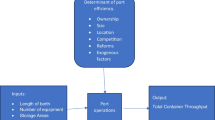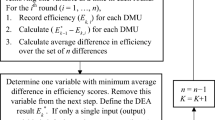Abstract
In this article, a non-parametric analysis of the efficiency of major international container shipping lines (CSLs) is conducted in order to evaluate the effects of the recent profound global economic crisis on such a crucial sector in seaborne trade. Data Envelopment Analysis (DEA) is applied to highlight the efficiency status of top CSLs using a bias-corrected efficiency estimator. In the first stage, hypotheses regarding the underlying production frontier of major international CSLs are tested. In the second stage, an output-oriented, non-increasing returns to scale DEA model is used to compute efficiency scores estimates of the different CSLs. The model considers labour, number of ships and fleet capacity as inputs, and container throughput handled and turnover as outputs. Confidence interval estimates of efficiency and returns to scale for each CSL are reported. The results of the analysis indicate that none of the CSLs assessed operates under constant returns to scale and that average efficiency is 0.74, finding considerable waste in the production of CSLs for the year 2009. In addition, the major international CSLs in 2009 have oversized operations that exceed the most productive scale size. The evidence suggests that strategic alliance membership is not a guarantee for efficient practices in operations. There must be other reasons, purportedly of a strategic nature, for CSLs to join such alliances.


Similar content being viewed by others
References
Banker, R.D. (1984) Estimating most productive scale size using Data Envelopment Analysis. European Journal of Operational Research 17 (1): 35–44.
Banker, R.D., Charnes, A. and Cooper, W.W. (1984) Some models for the estimation of technical and scale inefficiencies in Data Envelopment Analysis. Management Science 30 (9): 1078–1092.
Barros, C.P. (2003) The measurement of efficiency of Portuguese sea port authorities with DEA. International Journal of Transport Economics 30 (3): 335–354.
Charnes, A., Cooper, W.W. and Rhodes, E.L. (1978) Measuring the efficiency of decision making units. European Journal of Operational Research 2 (6): 429–444.
Containerisation International On line. (2011) Shipping lines, http://www.ci-online.co.uk/, accessed 31 July 2012.
Cullinane, K., Song, D., Ji, P. and Wang, T. (2004) An application of DEA window analysis to container port production efficiency. Review of Network Economics 3 (2): 186–208.
Cullinane, K., Song, D. and Wang, T. (2005) The application of mathematical programming approaches to estimating container port production efficiency. Journal of Productivity Analysis 24 (1): 73–92.
Cullinane, K., Ji, P. and Wang, T. (2006) The efficiency of European container ports: A cross-sectional Data Envelopment Analysis. International Journal of Logistics: Research and Applications 9 (1): 19–31.
Cullinane, K. and Wang, T. (2010) The efficiency analysis of container port production using DEA panel data approaches. OR Spectrum 32 (3): 717–738.
Das, S.S. (2011) To partner or to acquire? A longitudinal study of alliances in the shipping industry. Maritime Policy & Management 38 (2): 111–128.
De Borger, B., Kerstens, K. and Costa, A. (2002) Public transit performance: What does one learn from frontier studies? Transport Reviews 22 (1): 1–38.
Drewry Shipping Consultants. (2008/2009) Annual Review of Global Container Terminal Operators. London: International Marine Simulator Forum.
Emrouznejad, A., Parker, B.R. and Tavares, G. (2008) Evaluation of research in efficiency and productivity: A survey and analysis of the first 30 years of scholarly literature in DEA. Socio-Economic Planning Sciences 42 (3): 151–157.
Hwang, C. and Chung, C. (2005) An analysis of key influence factors for bulk carrier registrations in Taiwan. Transportation Planning Journal 34 (1): 27–62.
Kneip, A., Park, B.U. and Simar, L. (1998) A note on the convergence of nonparametric DEA estimators for production efficiency scores. Econometric Theory 14 (6): 783–793.
Lin, L.-C. and Tseng, L.A. (2005) Application of DEA and SFA on the measurement of operating efficiencies for 27 international container ports. Proceedings of the Eastern Asia Society for Transportation Studies 5: 592–607.
Lozano, S., Gutiérrez, E., Adenso-Díaz, B. and González-Torre, P. (2011) Efficiency assessment of shipping agents operating in Spanish ports. University of Oviedo, Department of Business Administration, School of Engineering. Working paper 11–005.
Lu, H.A., Cheng, J. and Lee, T.S. (2006) Evaluation of strategic alliances in liner shipping – An empirical study of CKYH. Journal of Marine Science and Technology 14 (4): 202–212.
Lun, Y.H.V., Lai, K.H. and Cheng, T.C.E. (2006) Shipping and Transport Logistics. Singapore: McGraw Hill.
Lun, Y.H.V. and Marlow, P. (2011) The impact of capacity on firm performance: A study of the liner shipping industry. International Journal of Shipping and Transport Logistics 3 (1): 57–71.
Ng, A.S.-F., Lim, A.L.C., Leong, C.H. and Cheng, C.H. (2010) A competitiveness measurement framework for regional container hub ports: A case study in East Asia. International Journal of Logistics Systems and Management 7 (3): 368–392.
Panayides, P.M., Lambertides, N. and Savva, C.S. (2011) The relative efficiency of shipping companies. Transportation Research Part E 47 (5): 681–694.
Panayides, P.M. and Wiedmer, R. (2011) Strategic alliances in container liner shipping. Research in Transportation Economics 32 (1): 25–38.
Park, K.R. and De, P. (2004) An alternative approach to efficiency measurement of seaports. Maritime & Logistics 6 (1): 53–69.
Roll, Y. and Hayuth, Y. (1993) Port performance comparison applying Data Envelopment Analysis. Maritime Policy and Management 20 (2): 153–161.
Silverman, B.M. (1986) Density Estimation for Statistics and Data Analysis. London: Chapman and Hall.
Simar, L. and Wilson, P.W. (1998) Sensitivity analysis of efficiency scores: How to bootstrap in nonparametric frontier models. Management Science 44 (1): 49–61.
Simar, L. and Wilson, P.W. (1999) Estimating and bootstrapping Malmquist indices. European Journal of Operational Research 115 (3): 459–471.
Simar, L. and Wilson, P.W. (2000) Statistical inference in nonparametric frontier models: The state of the art. Journal of Productivity Analysis 13 (1): 49–78.
Simar, L. and Wilson, P.W. (2002) Non-parametric tests of returns to scale. European Journal of Operational Research 139 (1): 115–132.
Song, D.-W. and Panayides, P. (2002) A conceptual application of cooperative game theory to liner shipping strategic alliances. Maritime Policy and Management 29 (3): 285–301.
Tongzon, J. (1995) Determinants of port performance and efficiency. Transport Research Part A 29 (3): 245–252.
Tongzon, J. (2001) Efficiency measurement of selected Australian and other international ports using Data Envelopment Analysis. Transport Research Part A 35 (2): 113–128.
UNCTAD. (2012) Review of Maritime Transport, http://www.unctad.org/en/PublicationsLibrary/rmt2012_en.pdf, accessed 4 August 2013.
Valentine, V.F. and Gray, R. (2001) The measurement of port efficiency using Data Envelopment Analysis. World Conference on Transport Research, Seoul, South Korea, 22–27 July, http://www.informare.it/news/forum/2000/sig2/valentinees.asp, accessed 12 June 2012.
Wang, T., Song, D. and Cullinane, K. (2003) Container port production efficiency: A comparative study of DEA and FDH approaches. Journal of Eastern Asia Society for Transportation Studies 5: 698–713.
Wang, T. and Cullinane, K. (2006) The efficiency of European container terminals and implications for supply chain management. Maritime Economics & Logistics 8 (1): 82–99.
Wilson, P.W. (1993) Detecting outliers in deterministic nonparametric frontier models with multiple outputs. Journal of Business and Economic Statistics 11 (3): 319–323.
Wilson, P.W. (2008) FEAR: A software package for frontier efficiency analysis with R. Socio-Economic Planning Sciences 42 (4): 247–254.
Acknowledgements
This research was carried out with the financial support of the Spanish Ministry of Science Grant DPI2010–16201, and FEDER. We are grateful to Professor Oleg Badunenko, University of Cologne (Germany), who kindly provided us with the R code for returns to scale tests of DEA efficiency scores. The authors would like to thank the anonymous reviewers for their constructive comments and suggestions.
Author information
Authors and Affiliations
Rights and permissions
About this article
Cite this article
Gutiérrez, E., Lozano, S. & Furió, S. Evaluating efficiency of international container shipping lines: A bootstrap DEA approach. Marit Econ Logist 16, 55–71 (2014). https://doi.org/10.1057/mel.2013.21
Published:
Issue Date:
DOI: https://doi.org/10.1057/mel.2013.21




